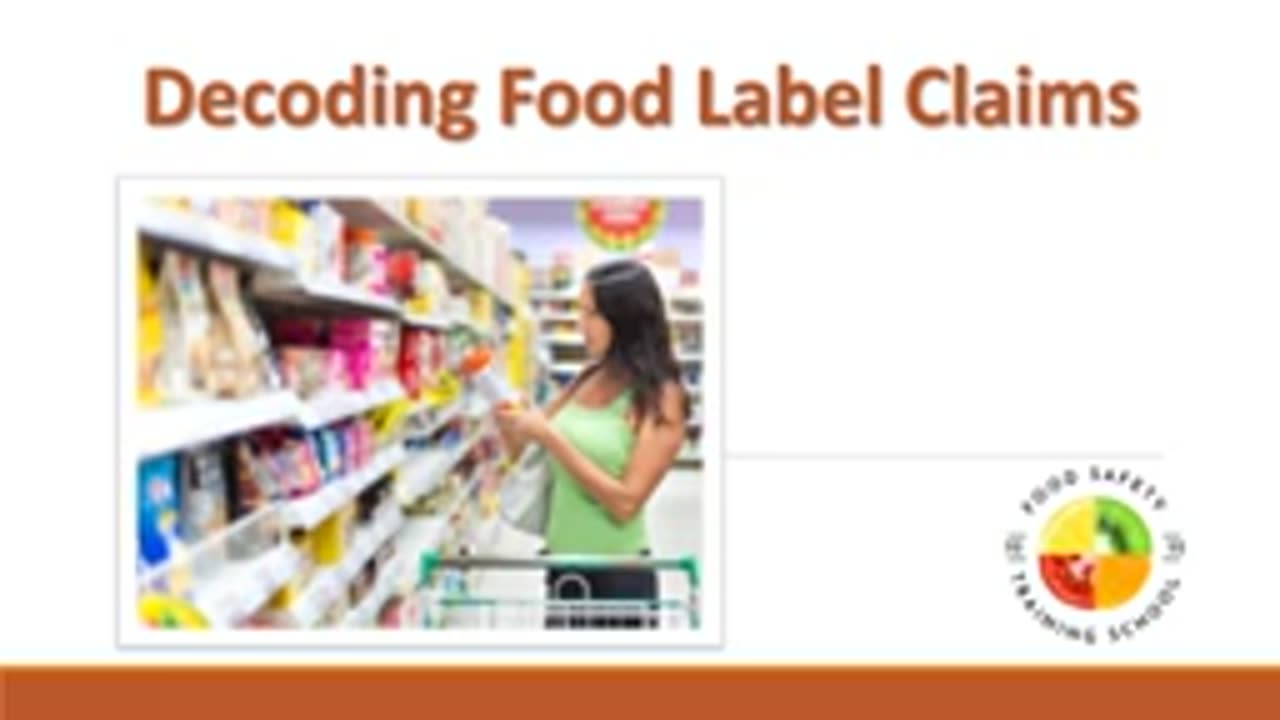Premium Only Content

Food Label Claims
Food label claims are statements or indications made on food packaging to inform consumers about the product's characteristics, nutritional value, health benefits, or compliance with certain standards. These claims must comply with regulatory guidelines to ensure they are not misleading. Below are the main types of food label claims:
---
### **1. Nutrient Content Claims**
- **Definition**: These claims describe the level or range of a specific nutrient in the product.
- **Examples**:
- "Low fat"
- "High in fiber"
- "Sugar-free"
- "Source of protein"
- **Regulations**: Specific thresholds must be met for a product to use such terms (e.g., "low sodium" means less than 140 mg of sodium per serving in the U.S.).
---
### **2. Health Claims**
- **Definition**: Claims that link a food or nutrient to a specific health benefit or reduced risk of disease.
- **Types**:
- **Authorized Health Claims**: Supported by substantial scientific evidence and approved by regulatory bodies.
- Example: "Calcium helps build strong bones."
- **Qualified Health Claims**: Based on emerging evidence but require a disclaimer about the level of scientific support.
- Example: "Some evidence suggests that eating whole grains may reduce the risk of heart disease."
- **Regulations**: Must be backed by credible scientific research and approved by organizations like the FDA, EFSA, or Codex Alimentarius.
---
### **3. Structure/Function Claims**
- **Definition**: Statements about how a nutrient or ingredient affects normal bodily functions, without mentioning disease prevention.
- **Examples**:
- "Supports immune health"
- "Promotes healthy digestion"
- **Regulations**: These claims do not require prior approval but must not be misleading and should be supported by scientific evidence.
---
### **4. Comparative Claims**
- **Definition**: Claims comparing the nutrient content of one product to another.
- **Examples**:
- "50% less sugar than regular soda"
- "Twice the fiber of leading cereals"
- **Regulations**: Must specify the reference product and the basis for comparison.
---
### **5. Natural and Organic Claims**
- **Natural**: Indicates that the product contains no artificial ingredients, preservatives, or colors and has been minimally processed.
- Example: "Made with 100% natural ingredients"
- **Organic**: Refers to food produced following organic farming practices, free from synthetic pesticides, fertilizers, and GMOs.
- Example: "Certified Organic"
- **Regulations**: Governed by specific certifications, such as USDA Organic or EU Organic.
---
### **6. Allergen-Free Claims**
- **Definition**: Indicates that a product does not contain specific allergens or has been processed in a way to eliminate cross-contamination.
- **Examples**:
- "Gluten-free"
- "Nut-free"
- **Regulations**: Subject to strict testing and compliance standards to ensure safety.
---
### **7. Environmental or Ethical Claims**
- **Definition**: Highlights sustainable, ethical, or eco-friendly practices.
- **Examples**:
- "Fair Trade Certified"
- "Sustainably sourced"
- "Carbon-neutral product"
- **Regulations**: Must meet certification standards and provide transparency.
---
### **8. Marketing Claims**
- **Definition**: Non-nutritional claims to appeal to consumer preferences.
- **Examples**:
- "Artisanal"
- "Homemade flavor"
- "Farm fresh"
- **Regulations**: These claims are often subjective and may not be strictly regulated but must not mislead consumers.
---
### **Importance of Regulatory Compliance**
- Ensures claims are accurate and evidence-based.
- Protects consumers from false or misleading information.
- Maintains trust in food brands and regulatory systems.
Would you like to explore specific examples or focus on any particular type of claim?
-
 8:50:58
8:50:58
Right Side Broadcasting Network
1 day ago🎅 LIVE: Tracking Santa on Christmas Eve 2024 NORAD Santa Tracker 🎅
341K49 -
 2:48
2:48
Steven Crowder
1 day agoCROWDER CLASSICS: What’s This? | Nightmare Before Kwanzaa (Nightmare Before Christmas Parody)
316K12 -
 33:49
33:49
Quite Frankly
1 day agoThe Christmas Eve Midnight Telethon
118K22 -
 2:12:46
2:12:46
Price of Reason
1 day agoAmber Heard BACKS Blake Lively Lawsuit Against Justin Baldoni! Is Disney CEO Bob Iger in TROUBLE?
69.1K24 -
 1:01:17
1:01:17
The StoneZONE with Roger Stone
20 hours agoChristmas Edition: Why the Panama Canal is Part of the America First Agenda | The StoneZONE
139K51 -
 18:12:15
18:12:15
LFA TV
1 day agoLFA TV CHRISTMAS EVE REPLAY
150K19 -
 13:32
13:32
Scammer Payback
21 hours agoChanging the Scammer's Desktop Background to his Location
18.9K4 -
 4:21
4:21
BIG NEM
1 day agoNikola Tesla's Secret to Cultivating Creativity & Genius
14.3K1 -
 15:03
15:03
The Anthony Rogers Show
1 day agoAnthony Rogers - Live at Cusumano's Pizza (Upstairs)
11.3K1 -
 4:33:48
4:33:48
tacetmort3m
1 day ago🔴 LIVE - THE ZONE KEEPS PULLING ME BACK - STALKER 2 - PART 15
75.7K13